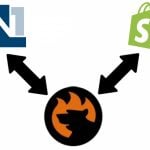Ecommerce Conversion Optimization for Magento, Shopify & Shopware: Built-in Free CRO Tools & Third-Party Solutions

In the wild world of online shopping, it’s not enough to just attract visitors—you need to turn them into customers, and that’s where ecommerce conversion optimization comes into play. Simply put, ecommerce CRO is the process of convincing more of your website visitors to complete a desired action, whether it’s making a purchase, signing up for a newsletter, or downloading a guide. But it’s not just about making more sales—it’s about squeezing the most value out of the traffic you already have without increasing your ad spend.
In this guide, we’re diving into the nitty-gritty of ecommerce conversion rate optimization for the big players: Magento, Shopify, and Shopware. These platforms come packed with built-in tools to help boost conversions, and there are tons of third-party solutions to take your CRO game to the next level. From A/B testing to FOMO-inducing pop-ups and AI-driven personalization, we’ve got all the tricks to help you turn those window shoppers into paying customers. Ready to optimize? Let’s dive in and explore the best free and paid CRO tools that can transform your ecommerce store into a sales machine or give you a boost with ghost commerce! And don’t forget to check our ecommerce glossary of terms to discover other useful definitions and insights that will help you sharpen your strategies and grow your business

Table of contents
- 1 What is Ecommerce Conversion Optimization? Turning Browsers into Buyers (Without Breaking the Bank)
- 2 A/B Testing CRO Tools: Unleashing Your Inner Mad Scientist
- 3 Personalization Tools: Making Shopping Feel Like Magic (But It’s Just Ecommerce CRO)
- 4 Customer Journey Analytics: Stalking Your Customers (But in a Totally Ethical Way & For The Sake of Ecommerce Conversion Optimization)
- 5 Cart Abandonment Recovery Tools: Because “I’ll Buy It Later” is the Enemy of Ecommerce CRO
- 6 On-site Retargeting CRO Tools (Exit-Intent Pop-ups): The Last-Minute Rescue Mission
- 7 Live Chat and Chatbots: The Digital Sales Assistant That Is Never Tired to Boost Ecommerce Conversion Optimization
- 8 FOMO (Fear of Missing Out) and Urgency CRO Tools: Turning Procrastinators into Purchasers
- 9 Ecommerce Conversion Optimization With Discounts & Promotions: Because Who Can Resist a Bargain?
- 10 Final Words
What is Ecommerce Conversion Optimization? Turning Browsers into Buyers (Without Breaking the Bank)
So, ecommerce conversion rate optimization — what’s that all about? Basically, it’s the art (and a little science) of convincing people to do exactly what you want when they land on your website. In the world of ecommerce, we’re usually talking about making a purchase. But hey, the ecommerce conversion optimization goals don’t stop there. Maybe you want them to sign up for your newsletter, download your killer guide, or even leave a glowing review. All of these little wins count!
At its core, ecommerce CRO is all about tweaking your site using data, user behavior insights, and sometimes just a dash of common sense. But here’s the good news: many ecommerce platforms already come packed with handy tools to improve your conversion rate — no data deep-diving required. Think chatbots that answer customer questions instantly, juicy discounts, or even a killer Meet the Team page that gives your brand a human touch (people love that stuff).
The best part? Optimizing for conversions lets you squeeze more value out of the traffic you already have, without pouring more money into ads. If your store isn’t doing any kind of ecommerce conversion rate optimization, you’re basically leaving cash just sitting there, waiting for someone else to grab it. A solid CRO strategy means more sales, happier customers who stick around, and a bump in profits.
While most of the time we’re talking about optimizing things like site performance, user experience, and the good ol’ Call to Action (CTA), we want to dig into some of the other fun stuff — like the free CRO tools built right into major ecommerce platforms and those sweet third-party solutions everyone’s buzzing about.
Ready to level up your ecommerce CRO? Here are some top tools and strategies that will have your conversion rates climbing faster than you can say “Add to Cart”!
A/B Testing CRO Tools: Unleashing Your Inner Mad Scientist
Think of A/B testing as running a fun little science experiment for the sake of ecommerce conversion optimization — minus the lab coat and safety goggles. By comparing different versions of your pages (like which headline converts better or whether that shiny new “Buy Now” button is actually doing its job), you can make data-driven decisions that really move the needle on your ecommerce conversion rates. And trust us, even the smallest tweak can make a big difference.
A/B testing is like having a crystal ball for your website. Want to know if a red “Buy Now” button performs better than a green one? Run an A/B test. Curious if a bold headline turns more visitors into buyers? A/B test it. By putting your theories to the test, you can identify which design, content, or layout changes resonate most with your audience and optimize the parts of your site that matter most — like product pages and checkout.
But here’s the kicker: none of the big players give you A/B testing out of the box. Yep, you’ll have to get creative.

Unfortunately, Magento doesn’t have built-in A/B testing capabilities (sad face). But fear not! Magento Marketplace is here to save the day with a range of third-party extensions that’ll turn you into an A/B testing wizard. Also, read this article to get more informations on how to A/B test your Magento storefront:
Shopify is the same. It might not have A/B testing built in, but of course, Shopify App Store comes to the rescue with a variety of ecommerce conversion optimization solutions. You’ve got options like and that can help you test every aspect of your store, from page layouts to checkout buttons.
Like Magento and Shopify, Shopware doesn’t offer a built-in A/B testing solution either. But that’s nothing a good plugin can’t fix! Head over to Shopware’s plugin store, type in “,” and start running experiments like the ecommerce mastermind you are.
Personalization Tools: Making Shopping Feel Like Magic (But It’s Just Ecommerce CRO)
You know that moment when a website seems to read your mind and serves up the perfect product you didn’t even know you needed? That’s not magic — it’s ecommerce conversion rate optimizations based on personalization tools working behind the scenes. By analyzing a shopper’s behavior, location, or preferences, these tools create a customized experience that feels more like a VIP tour than a casual browse. And when customers feel understood, they’re way more likely to convert.
Imagine walking into a store and, instead of aimlessly wandering around, someone hands you exactly what you’re looking for (plus a sweet discount on that thing you didn’t even know you wanted).
That’s what personalization tools do from the perspective of ecommerce conversion optimization. Whether it’s suggesting products based on previous purchases or offering tailored promotions, these instruments make shopping relevant, engaging, and, most importantly, conversion-friendly.
So how do the big players handle personalization? Let’s dive in.
When it comes to built-in personalization features, Magento isn’t messing around. With tools like Customer Segmentation and Related Products, Magento lets you deliver highly personalized product recommendations based on user behavior.
Want to upsell, cross-sell, or just nudge customers toward the products they’ll love? Magento’s got your back with built-in features that help you fine-tune every step of the customer journey. Simply go to Marketing → Promotions → Magento 2 Related Products, Upsells, and Cross-sells.
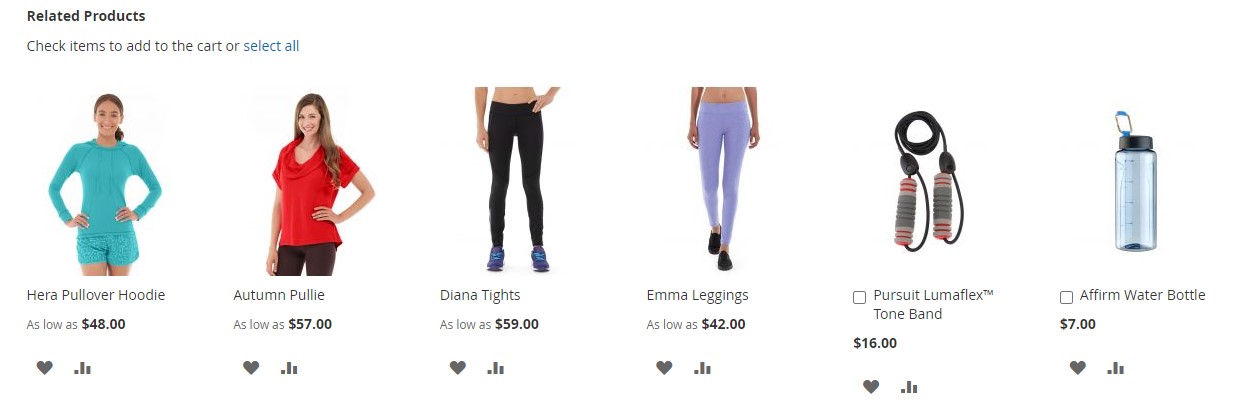
Shopify may not have the built-in personalization firepower of Magento, but don’t worry — it plays nice with tons of third-party apps. For advanced personalization, tools like or (a totally different angle of personalization) come to the rescue, offering AI-driven product recommendations, personalized pop-ups, and more. If you’re looking for something simple, Shopify’s Built-in Recommendations can automatically suggest products based on what users have viewed or bought before. Path: Themes → Customize → Product pages → .
Shopware brings its own personalization game with built-in tools like Customer Groups (Customers → Customer Groups) and the Advanced Promotion Suite (Marketing → Advanced Promotion Suite). This allows you to segment your audience and target them with personalized promotions, discounts, or product recommendations based on behavior or preferences.
Customer Journey Analytics: Stalking Your Customers (But in a Totally Ethical Way & For The Sake of Ecommerce Conversion Optimization)
Ever wish you could see exactly what your website visitors are doing — like, what’s taking them so long to buy those socks? Well, that’s where Customer Journey Analytics swoops in like a detective with a magnifying glass, tracking every move your customers make. These CRO tools analyze the entire user journey, from the moment they land on your site to the second they (hopefully) click “Checkout.” More importantly, they help you figure out where people are dropping off or getting stuck — aka, where you’re losing potential sales.
Imagine you’re hosting a dinner party, and guests keep leaving halfway through your gourmet meal. Wouldn’t you want to know why? Maybe it’s the appetizer. Maybe they’re getting lost on the way to the bathroom.
Customer Journey Analytics works the same way — it shows you exactly where customers are getting cold feet in your sales funnel so you can fix it. Is your checkout page driving people away? Is your landing page a dead end? These tools provide the answers, helping you plug those conversion leaks and boost your ecommerce conversion rate optimization.
Let’s break down how Magento, Shopify, and Shopware handle this.
Magento doesn’t come with built-in customer journey analytics, but fear not — it’s an integration superstar. You can seamlessly connect tools like Hotjar or Crazy Egg to track your visitors’ every move. Whether you want heatmaps to see where people are clicking or full session recordings (yes, it’s as creepy as it sounds but super useful), these tools have you covered. Or go to Stores → Configuration → Sales → Google API → Google Analytics to enable Google’s instruments.
With Shopify, you’re not flying blind. Shopify comes with built-in Google Analytics integration (Preferences → Google Analytics → Input tracking ID), so you can keep tabs on what’s working and what’s flopping. For a deeper dive into the customer journey, apps like can give you heatmaps, scroll maps, and even replay sessions to see exactly where users are losing interest.
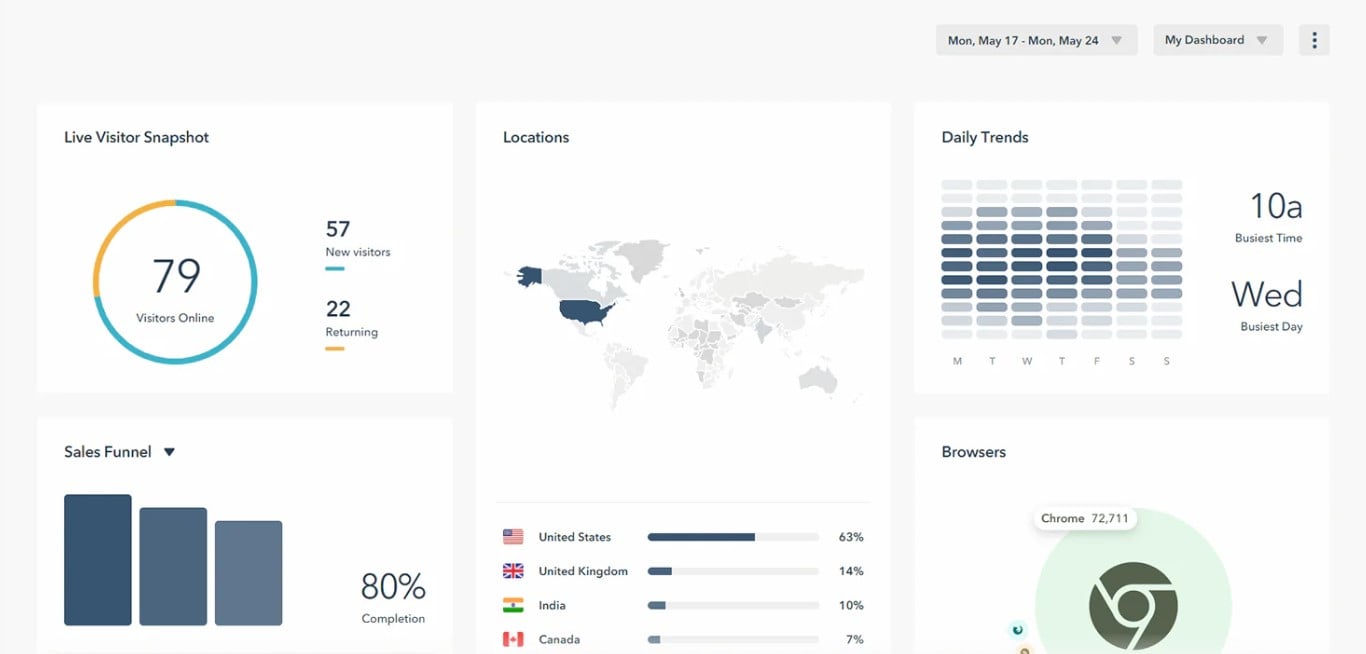
Shopware also doesn’t have built-in customer journey tracking, but you can easily install plugins like Hotjar or Matomo (if you’re into self-hosted solutions). These tools will provide you with deep insights into where users click, scroll, or bounce — so you can identify the friction points in your sales funnel.
Cart Abandonment Recovery Tools: Because “I’ll Buy It Later” is the Enemy of Ecommerce CRO
Ever had that moment where you’ve filled up your cart with goodies and then, for some inexplicable reason, you just… leave? Yeah, your customers do that too. And it’s a heartbreaker for ecommerce businesses. That’s where Cart Abandonment Recovery Tools come to the rescue, swooping in like a superhero to remind your customers, “Hey, don’t forget those socks!” Whether through follow-up emails, push notifications, or pop-ups, these tools help lure customers back to complete their purchases. And honestly, who can resist a well-timed “Hey, here’s 10% off” email?
Abandoned carts are like unfinished novels — so much potential, yet so much left behind. And the kicker? About 70% of online shopping carts get abandoned before checkout. That’s a whole lot of missed revenue.
Cart abandonment recovery tools help you close the deal by sending gentle (or not-so-gentle) reminders to customers about their forgotten treasures. Offering a discount, free shipping, or even just a friendly nudge can turn those “I’ll buy it later” moments into “I’ll buy it now!” decisions becoming a powerful ecommerce conversion optimization technique.
Good news for Magento users! The platform comes equipped with a built-in feature for Abandoned Cart Emails – Marketing → Communications → Email Reminders → create a reminder for abandoned carts. This tool automatically sends out email reminders to customers who’ve ditched their carts mid-shopping spree, giving you a chance to reel them back in. Plus, you can customize the emails to include discounts or other incentives that’ll make them think, “How could I not finish this purchase?”

Shopify also has your back with built-in Abandoned Checkout Recovery Emails – Settings → Checkout → Scroll down to Abandoned Checkout Emails. When customers ghost their carts, Shopify automatically sends them a reminder email to finish the checkout process. Merchants can customize these emails with a little extra love — like a discount code or a free shipping offer — to sweeten the deal. All you need to do is set it up, and Shopify does the rest.
While Shopware doesn’t come with a built-in cart recovery tool, don’t worry — there’s a plugin for that! With tools like , you can set up automatic follow-ups to help nudge your forgetful shoppers back to their carts. Just install one of these handy plugins, and you’ll be on your way to salvaging those lost sales.
On-site Retargeting CRO Tools (Exit-Intent Pop-ups): The Last-Minute Rescue Mission
Picture this: a customer is casually browsing your store, eyeing a couple of items, and just as they’re about to leave without buying a thing — bam! — an exit-intent pop-up appears, offering them 10% off if they stay and finish their purchase. These sneaky little pop-ups are like digital bouncers, keeping your customers from making an early exit. By detecting when someone is about to leave your site, on-site retargeting tools trigger a last-ditch effort to reel them back in, whether with a discount, free shipping, or just a gentle nudge reminding them of what they’re missing out on.
Exit-intent pop-ups are like your website’s version of, “Wait! Before you go, I’ve got something for you!” And let’s face it — they perform quite well in ecommerce conversion optimization. Such CRO tools reduce bounce rates and cart abandonment by giving your visitors one more reason to stay or make that final purchase. Whether it’s a limited-time offer, free shipping, or even a special download, exit-intent pop-ups can be the difference between losing a sale and converting a customer at the last second. Think of them as the superhero of ecommerce conversion rate optimization — showing up just in time to save the day.
Sadly, Magento doesn’t come with built-in exit-intent pop-ups, but don’t panic! You can still add this conversion-boosting feature by integrating third-party tools:
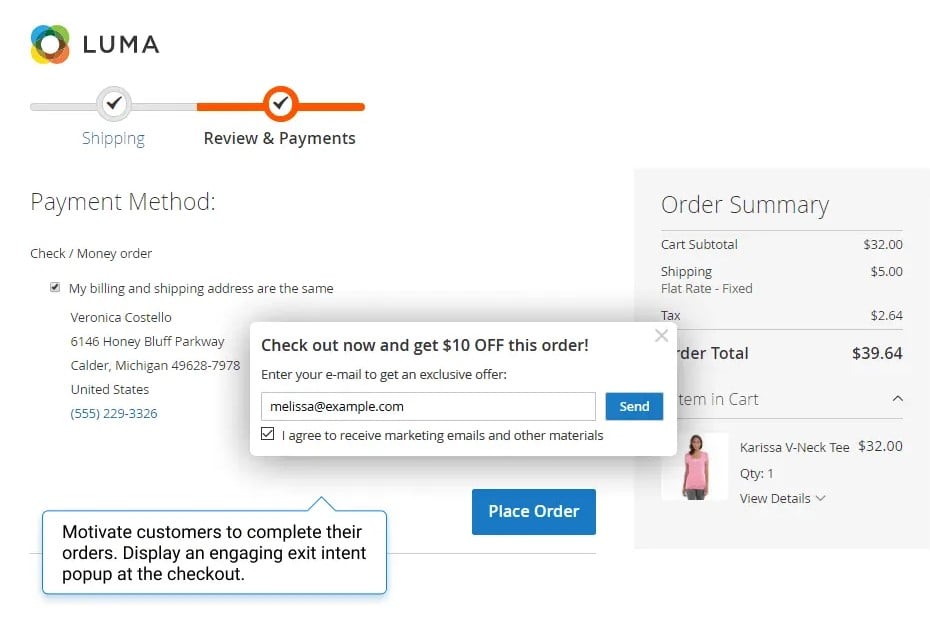
Like Magento, Shopify doesn’t have native exit-intent pop-ups, but its App Store is full of apps ready to help you catch customers before they flee. Tools like or allow you to display pop-ups just as visitors are about to leave. These apps are easy to integrate and can be customized to offer discounts, special content, or even a heartfelt, “Wait! Don’t go!”
Shopware is also missing built-in exit-intent pop-ups, but just like its competitors, you can easily fix that with a plugin. Tools like offer a seamless way to keep your visitors engaged right when they’re about to hit the “X” button. A well-timed discount or offer might just be what convinces them to stick around and convert.
Live Chat and Chatbots: The Digital Sales Assistant That Is Never Tired to Boost Ecommerce Conversion Optimization
Imagine walking into a store, and immediately there’s someone there to help you with everything — but without that awkward, hovering feeling. That’s exactly what live chat and chatbots bring to your online store. These ecommerce conversion optimization tools offer real-time assistance to customers, helping them find products, answer their questions, and even guide them through the checkout process. Whether it’s a quick “Where can I find this?” or “Help! My coupon isn’t working,” chatbots step in before customers abandon their carts in frustration.
If there’s one thing that can kill a sale faster than a confusing checkout, it’s unanswered questions. AI chatbots solve this problem instantly by providing real-time support, helping customers feel confident and cared for. Whether it’s a simple product query or an issue that needs troubleshooting, live chat reduces the friction of online shopping. And when things are smooth, conversions skyrocket. Plus, chatbots work 24/7, never need a coffee break, and can even make product recommendations — talk about a hard worker!
For Magento users, live chat tools can be easily integrated using top-tier extensions by Amasty or Mirasvit. Both offer highly customizable solutions to ensure your customers always have access to help when they need it. Amasty’s live chat Magento 2 module, for example, allows direct communication with your customers, while Mirasvit’s AI-powered chatbot takes care of the repetitive inquiries — giving your human agents a well-deserved break!
Shopify comes with a built-in live chat option called Shopify Inbox, which makes it easy for merchants to chat with customers directly. However, if you want to level up with more advanced features, third-party apps like and offer sophisticated chatbots, AI responses, and deep integrations that can turn your chat into a sales powerhouse. These apps allow you to manage multiple communication channels, including live chat, email, and social media.
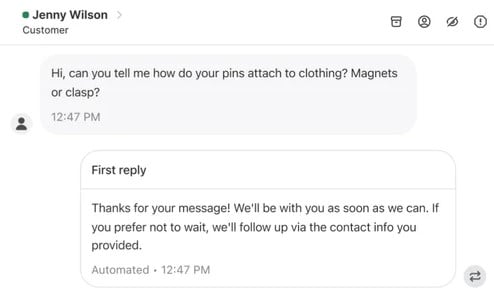
When it comes to Shopware, you’ll be relying on plugins like or for your chatbot and live chat needs. These plugins provide smooth, real-time customer support that can dramatically improve your ecommerce conversion optimization by answering questions, resolving issues, and guiding customers through to checkout. And because they’re highly customizable, you can tailor the experience to match your store’s unique style.
FOMO (Fear of Missing Out) and Urgency CRO Tools: Turning Procrastinators into Purchasers
Let’s face it — nothing lights a fire under a shopper quite like the fear of missing out on a killer deal. Whether it’s a countdown timer ticking away or a low stock alert flashing red, FOMO and urgency tools are the digital equivalent of “Act now before it’s too late!” These tools are designed to hit customers with the one-two punch of scarcity and time sensitivity, convincing them to complete that purchase right now — because who wants to be the one who misses out?
FOMO and urgency are psychological triggers of ecommerce conversion rate optimization that work because they create a sense of “Oh no, if I wait, I’ll lose this deal forever!” Whether it’s a flash sale with a timer counting down or a low inventory notice on that must-have item, these tools turn hesitation into action. When customers feel like they’re in a race against time (or stock), their decision-making speeds up, which means conversion rates climb. Plus, who doesn’t love a good adrenaline rush with their online shopping?
Now, let’s dive into how Magento, Shopify, and Shopware crank up the urgency with these nifty tools.
Magento knows a thing or two about leveraging urgency, but it calls on some superhero extensions to get the job done. Need a countdown timer for that flash sale or a custom-stock notification to make customers sweat a little? These Magento extensions let you do just that. With Amasty’s urgency tools, you can add scarcity messaging and limited-time deals, while Mirasvit’s tools create that “only 2 left in stock!” panic that drives sales.
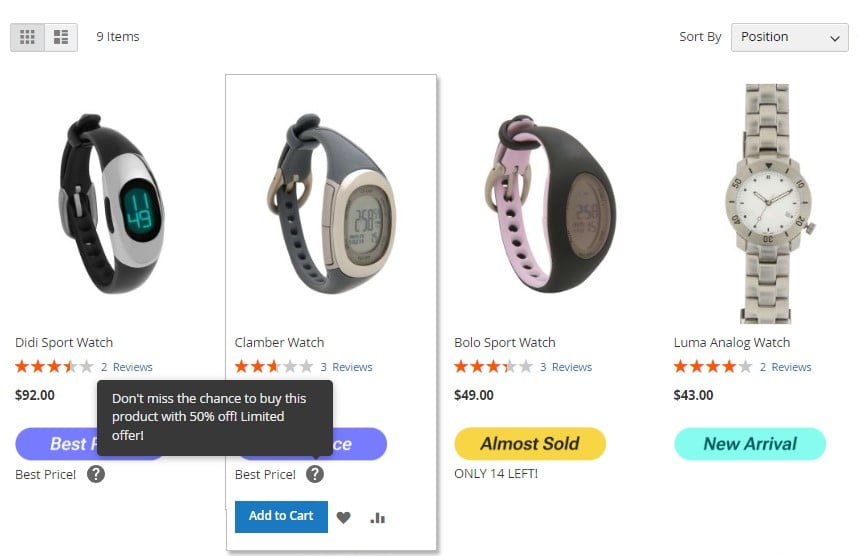
Shopify knows how to stoke the flames of like Hurrify and Countdown Timer Bar. These apps add countdown timers, flash sale banners, and low stock alerts to your product pages, making sure your customers know the clock is ticking. Whether you’re hyping up a time-sensitive discount or letting them know that only a few items are left in stock, these apps turn browsing into impulse buying — just the way you like it.
While Shopware doesn’t come with built-in urgency features, fear not — there’s a plugin for that. With tools like , you can create that classic race-against-the-clock vibe on your product pages. Add in low-stock notifications and you’re well on your way to pushing those customers from “Hmm, maybe later” to “Take my money!”
Ecommerce Conversion Optimization With Discounts & Promotions: Because Who Can Resist a Bargain?
Let’s be real — who doesn’t love a good discount? Whether it’s 10% off your favorite sneakers or a BOGO (Buy One, Get One) deal on that fancy coffee maker, discounts and promotions tap into our primal need to get a great deal. These offers make customers feel like they’re winning, and when people feel like winners, they’re far more likely to hit “Buy Now.
Discounts lower the psychological barrier to purchasing by reducing the price, which automatically makes customers think, “Well, I have to buy this now!” Throw in some time-sensitive offers or exclusive discounts, and boom — you’ve created an urgency that’s too tempting to ignore. Not only do these strategies boost conversions, but they also encourage repeat purchases, upsells, and cross-sells, making them the secret sauce for improving Average Order Value (AOV). Plus, everyone loves a deal. Everyone.
So, how do Magento, Shopify, and Shopware handle the art of irresistible discounts? Let’s dive in.
Magento is practically a magician when it comes to setting up promotions. With its built-in Promotions Engine (Marketing → Promotions → Cart Price Rules and Catalog Price Rules), you can whip up all kinds of enticing offers — think cart price rules, special discounts, and limited-time promotions. Want to reward your top customers with a personalized deal? No problem. Need to create a flash sale with automatic discounts? Magento’s got your back. It’s like having a full-time promotions team in your back pocket.
Shopify keeps things simple with its built-in support for discount codes and promotions. Whether you want to offer a percentage off, free shipping, or a specific dollar amount discount, Shopify makes it ridiculously easy to set up and manage. Just head to your Discounts section (Discounts → Create Discount), create your offer, and watch the conversions roll in. You can also set time limits to add a sense of urgency, making it perfect for flash sales and holiday promos.
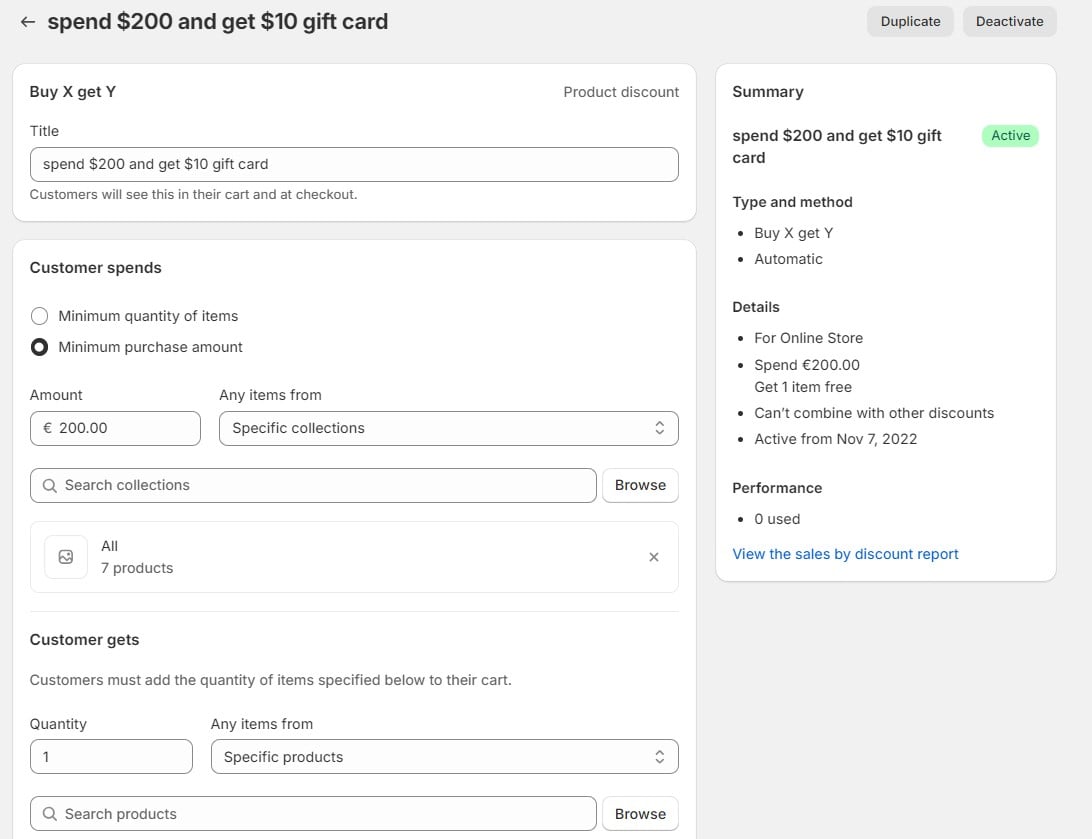
Shopware takes discounting to the next level with its Advanced Promotion Suite (Marketing → Advanced Promotion Suite). This built-in tool lets you create and manage discounts, vouchers, and promotional rules like a pro. Whether it’s a sitewide sale, free gifts with purchase, or tiered discounts, Shopware has everything you need to run complex promotions. You can even combine offers to boost AOV and keep customers coming back for more.
Final Words
By now, you’ve seen just how powerful ecommerce conversion optimization can be when you leverage the right tools and strategies. Whether it’s tweaking your store’s layout, adding a chatbot to answer customer questions, or throwing in some last-minute FOMO pop-ups to close the sale, there’s a wealth of options at your fingertips. Platforms like Magento, Shopify, and Shopware make it easier than ever to implement CRO with built-in tools, while third-party extensions offer even more advanced features to drive those conversions higher.
The beauty of ecommerce CRO is that it doesn’t require more traffic or bigger ad budgets — just smarter use of the traffic you already have. With A/B testing, you can fine-tune every element of your site to see what works best. Personalization tools help deliver a tailored shopping experience that feels like it was designed specifically for each customer. And don’t forget about the power of cart abandonment recovery tools and exit-intent pop-ups —those features alone can save tons of potential sales by nudging hesitant buyers back to complete their purchase.
It’s also important to remember that CRO is not a one-and-done kind of thing — it’s a continuous process. Testing, analyzing, and tweaking will help you keep pace with changing customer behaviors and trends. The right combination of tools can help you create a seamless, engaging shopping experience, one that keeps customers coming back for more.
So, what’s the next step? It’s time to get hands-on. Dive into your platform’s built-in ecommerce conversion optimization features, explore third-party solutions, and start experimenting. Whether you’re running a small store or managing a large ecommerce empire, there’s always room to improve your conversion rates and grow your business. Remember, every tweak and adjustment you make brings you one step closer to turning more visitors into loyal customers. Happy optimizing!





